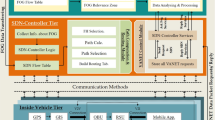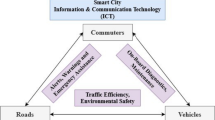Abstract
Recently, intelligent transportation systems (ITSs) have emerged. These systems can improve traditional transportation systems and provide traffic information to travelers. In the area of transportation, wireless sensor networks (WSNs) can replace the existing wired sensors and expensive traffic monitoring systems to mitigate the time and costs of installing such systems. However, accurate and on-time traffic information delivery is a major challenge, considering the energy constraints of sensor nodes. In this paper, we propose a two-tier architecture that includes a network of mobile objects (vehicles) in the upper layer and a hierarchical WSN in the bottom layer. Using this approach, a portion of loads on the low-power static sensor nodes can be transferred to mobile objects, such as powerful mobile devices. Moreover, to provide accurate and timely traffic information, a QoS-aware link cost function has been proposed and used for data transmission between the static sensor nodes. In addition, due to the mobility of the objects and the probability of losing packets in the mobile object tier, a reliable data forwarding mechanism has been proposed for this tier. In this mechanism, data packets are forwarded to the neighbors, which enhance the probability of the packets’ being received. The performance evaluation results indicate the effectiveness of the proposed architecture and data reporting mechanism for use in ITS applications.











Similar content being viewed by others
References
Akyildiz IF, Kasimoglu IH (2004) Wireless sensor and actor networks: research challenges. Ad Hoc Netw 2(4):351–367
Anisi MH, Abdullah AH, Razak SA, Ngadi MA (2012) Overview of data routing approaches for wireless sensor networks. Sensors 12(4):3964–3996
Anisi MH, Abdullah AH, Razak SA (2013) Energy-efficient and reliable data delivery in wireless sensor networks. Wirel Netw 19(4):495–505
Bettstetter C, Resta G, Santi P (2003) The node distribution of the random waypoint mobility model for wireless ad hoc networks. Mobile Comput IEEE Trans 2(3):257–269
Bhattacharyya D, Kim TH, Pal SA (2010) A comparative study of wireless sensor networks and their routing protocols. Sensors 10:10506–10523
Camp T, Boleng J, Davies V (2002) A survey of mobility models for ad hoc network research. Wirel Commun Mob Comput 2(5):483–502
Chang BR, Tsai HF, Young CP (2010) Intelligent data fusion system for predicting vehicle collision warning using vision/GPS sensing. Expert Syst Appl 37(3):2439–2450
Chen D, Varshney PK (2006) On demand geographic forwarding for data delivery in wireless sensor networks. Comput Commun 30(14–15):2954–2967
Chen S, Chen F, Liu J, Wu J, Bienkiewicz B (2010) Mobile mapping technology of wind velocity data along highway for traffic safety evaluation. Trans Res C Emerg Technol 18(4):507–518
Chen YB, Lam WHK, Sumalee A, Li Q, Shao H, Fang Z (2013) Finding reliable shortest paths in road networks under uncertainty. Netw Spat Econ 13(2):123–148
Choe HJ, Ghosh P, Das SK (2010) QoS-aware data reporting control in cluster-based wireless sensor networks. Comput Commun 33:1244–1254
Coleri S, Cheung SY, Varaiya P (2004) Sensor networks for monitoring traffic. In: Proc. of Allerton Conf
Cordeiro CDM, Agrawal D (2006) Ad-hoc & sensor networks: theory and application. World scientific Publisher, USA
Crainic TG, Gendreau M, Potvin J-Y (2009) Intelligent freight-transportation systems: assessment and the contribution of operations research. Trans Res C Emerg Technol 17(6):541–557
Faouzi N-EE, Leung H, Kurian A (2011) Data fusion in intelligent transportation systems: progress and challenges – A survey. Inf Fusion 12(1):4–10
Güner AR, Murat A, Chinnam RB (2012) Dynamic routing under recurrent and non-recurrent congestion using real-time ITS information. Comput Oper Res 39(2):358–373
Heinzelman WB, Chandrakasan AP, Balakrishnan H (2000) Energy efficient communication protocol for wireless microsensor networks. In: Proceedings of the 33rd Hawaaian Interantional Conference on System Science, Hawaii
Hickman JS, Hanowski RJ (2011) Use of a video monitoring approach to reduce at-risk driving behaviors in commercial vehicle operations. Transport Res F: Traffic Psychol Behav 14(3):189–198
Huang JH, Wang LC, Chang CJ (2008) QoS provisioning in a scalable wireless mesh network for intelligent transportation systems. IEEE Trans Veh Technol 57(5):3121–3135
Jin W-L (2014) Advances in dynamic traffic assgmnt: TAC. Netw Spat Econ. doi:10.1007/s11067-014-9250-x
Karpinski M, Senart A, Cahill V (2006) Sensor networks for smart roads. In: Proc. of IEEE PerCom Workshops, Pisa, Italy
Kottapalli V, Kiremidjian A, Lynch J, Carryer E, Kenny T, Law K, Lei Y (2003) Two-tiered wireless sensor network architecture for structural health monitoring, in: The 10th Annual International Symposium on Smart Structures and Materials, San Diego, USA, March 2003
Laborczi P, Mezny B, Török A, Ruzsa Z (2010) Query-based information gathering in intelligent transportation systems. Electron Notes Discrete Math 36:1201–1208
Lee S, Ghosh DYA (2008) Intelligent parking lot application using wireless sensor networks. In: Proc. of CTS, Irvine, CA, USA
Lee S, Younis M (2010) Recovery from multiple simultaneous failures in wireless sensor networks using minimum Steiner tree. J Parallel Distrib Comput 70(5):525–536
Lee J, Chung W, Kim E (2013) A new kernelized approach to wireless sensor network localization. Inf Sci 243:20–38
Li LI, Liu YA, Tang BH (2007) SNMS: an intelligent transportation system network architecture based on WSN and P2P network. J China Univ Posts Telecommun 14(1):65–70
Lin X, Tampere CMJ, Immers B (2014) The cost of environmental constraints in traffic networks: assessing the loss of optimality. Netw Spat Econ. doi:10.1007/s11067-014-9228-8
Madden S, Franklin MJ, Hellerstein JM, Hong W (2002) TAG: a tiny aggregation service for ad-hoc sensor networks. In: ACM SIGOPS Operating Systems Review, Boston, MA, USA, Dec 2002
Miranda-Moreno LF, Fu L (2006) A comparative study of alternative model structures and criteria for ranking locations for safety improvements. Netw Spat Econ 6(2):97–110
Misra S, Thomasinous PD (2010) A simple, least-time, and energy-efficient routing protocol with one-level data aggregation for wireless sensor networks. J Syst Softw 83(5):852–860
Misra S, Tiwari V, Obaidat MS (2009) LACAS: learning automata-based congestion avoidance scheme for healthcare wireless sensor networks. IEEE J Sel Areas Commun 27(4):789–817
Munaka T, Yamamoto T, Watanabe T (2005) A reliable advanced-join system for data multicasting in ITS networks. IEEE Trans Intell Transp Syst 6(4):424–438
Qin X, Khan AM (2012) Control strategies of traffic signal timing transition for emergency vehicle pre-emption. Trans Res C Emerg Technol 25:1–17
Rupi F, Bernardi S, Rossi G, Danesi A (2014) The evaluation of road network vulnerability in mountainous areas: a case study. Netw Spat Econ. doi:10.1007/s11067-014-9260-8
Simroth A, Zahle H (2011) Travel time prediction using floating car data applied to logistics planning. IEEE Trans Intell Transp Syst 12(1):243–253
Sobeih A, Hou J, Kung L-C, Li N, Zhang H, Chen W-P, Tyan H-Y, Lim H (2006) J-Sim: a simulation and emulation environment for wireless sensor networks. IEEE Wirel Commun 13(4):104–119
Soro S, Heinzelman WB (2005) Prolonging the lifetime of wireless sensor networks via unequal clustering. In: Proceedings of the 19th IEEE International Parallel and Distributed Processing Symposium (IPDPS’05), 260–264, Denver, Colorado
Stojmenovic I, Lin X (2001) Loop-free hybrid single-path/flooding routing algorithms with guaranteed delivery for wireless networks. IEEE Trans Parallel Distrib Syst 12(10):1023–1032
Tacconi D, Miorandi D, Carreras L, Chiti F, Fantacci R (2010) Using wireless sensor networks to support intelligent transportation systems. Ad Hoc Netw 8(5):462–473
Tang V, Yuan Z, Jiannong C (2006) An intelligent car park management system based on wireless sensor networks. In: Proc. of ISWPC, Phuket, Thailand
Tonguz O, Wisitpongphan N, Bai F, Mudalige P, Sadekar V (2007) Broadcasting in VANET. In: Proceedings of 2007 mobile networking for vehicular environments 7–12, Anchorage, Alaska
Xiangning F, Yulin S (2007) Improvement on LEACH protocol of wireless sensor network. In: Proceedings of international conference on sensor technologies and applications (SENSORCOMM 2007), 260–264, Valencia, Spain
Xie F, Levinson D (2009) Modeling the growth of transportation networks: a comprehensive review. Netw Spat Econ 9(3):291–307
Yick J, Mukherjee B, Ghosal D (2008) Wireless sensor network survey. Comput Netw 52(12):2292–2330
Zhang J, Wang FY, Wang K, Lin WH, Xu X, Chen C (2011) Data-driven intelligent transportation systems: a survey. IEEE Trans Intell Transp Syst 12(4):1624–1639
Zhao F, Guibas L (2004) Wireless sensor networks: an information processing approach. Elsevier/Morgan-Kaufmann, Boston
Zografos KG, Androutsopoulos KN, Spitadakis V (2009) Design and assessment of an online passenger information system for integrated multimodal trip planning. IEEE Trans Intell Transp Syst 10(2):311–323
Acknowledgement
The authors thank University of Malaya for the financial support (UMRG grant RG325-15AFR) and facilities to carry out the work.
Author information
Authors and Affiliations
Corresponding author
Rights and permissions
About this article
Cite this article
Anisi, M.H., Abdullah, A.H. Efficient Data Reporting in Intelligent Transportation Systems. Netw Spat Econ 16, 623–642 (2016). https://doi.org/10.1007/s11067-015-9291-9
Published:
Issue Date:
DOI: https://doi.org/10.1007/s11067-015-9291-9




